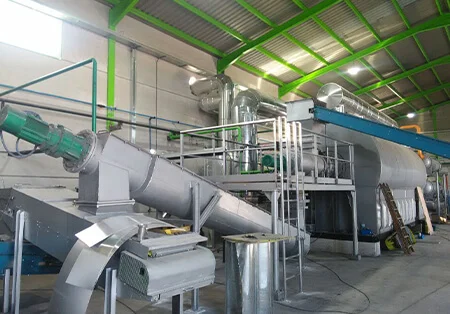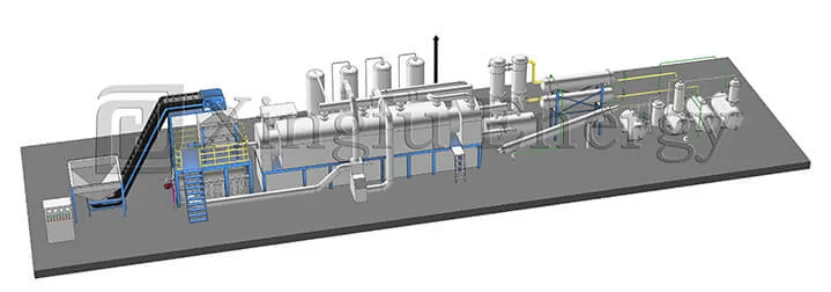Pyrolysis is a process that uses heat to break things down. It happens without any air or oxygen around. This trick is used to turn old tires into stuff like fuel oil, carbon black, and steel wire. Here’s how it goes: you heat the tires up a lot. That high heat splits them into tiny bits or molecules.

Pyrolysis is a big deal when it comes to handling waste. It’s a clean way to deal with things like tires that don’t rot away on their own. By changing junk into useful, energy-filled products, it keeps landfills from piling up. Plus, it helps bring back resources and cuts down on dirty air or water.
Pyrolysis isn’t like other ways of breaking stuff down with heat. Take burning, or incineration—it needs oxygen and spits out smoky leftovers. Pyrolysis? No oxygen at all. That means fewer nasty fumes. Then there’s gasification, which uses a little oxygen to partly break things down. Pyrolysis skips that. It’s all about using heat to chop things up, no burning involved.
Old tires have rubber, fillers like carbon black, steel wires, and some extra bits mixed in. These parts play a role in how pyrolysis turns out. The steel wire, for example, has to be pulled out later. But that’s okay—it’s worth recycling. Everything in the tire affects how much you get out of the process.

A few things decide if tire pyrolysis goes smoothly. Temperature is a big one. You need it just right to turn tires into oil and gas. How fast you heat things up changes the mix too. Go slow, and you get more oil. Speed it up, and you’ll see more gas. The reactor—the machine doing the job—needs to spread heat evenly. Its shape also affects how much you can collect at the end.
One of the main things you get is tire-derived oil. This stuff works great as fuel. It can run diesel motors that pack a punch but don’t spin fast. It’s also good for heating ovens, metalworking fires, or big factory furnaces. Since it’s packed with energy, it’s handy for all kinds of jobs.
Pyrolysis also leaves behind char. This is a mix of leftover carbon black and some gritty bits. You can tweak it into activated carbon. Or use it to bulk up rubber products. Places like Pyrolysis Plant and Oil Distillation Equipment Manufacturer make sure the char comes out top-notch by keeping the process tight.
Then there’s syngas, another handy leftover. It’s mostly hydrogen, methane, and carbon monoxide. You can burn it to make power cleanly. Or use it as a starting point to whip up chemicals. Either way, it’s got real potential.
Pyrolysis does a lot to shrink landfill piles. It also keeps the environment cleaner. By turning tires into useful things, it stops them from clogging up dump sites. That’s a win—tires take up tons of space and can even catch fire. On top of that, it keeps harmful stuff from leaking out. It’s way better than just tossing tires aside like in the old days.
This process isn’t just good for the earth—it can fill your pockets too. The stuff it makes, like fuel oil, carbon black, and steel wire, sells well. That fuel oil runs diesel motors with big power and slow turns. It heats furnaces for metalwork or industry too. Carbon black gets snapped up for rubber goods and dyes. The steel wire? It’s recyclable and always in demand. All this creates cash flow and jobs, making pyrolysis a smart business move.
Pyrolysis has its upsides, but it’s not perfect yet. There are some kinks to work out. The reactor has to be built right to spread heat and grab all the goods. Temperature and heating speed need tweaking too. Get those right, and you’ll pull out more oil and syngas. Folks are studying hard to smooth these bumps out. The aim? Make it run better and rake in more profit.
The future looks good for tire pyrolysis. Better reactors and tech like automation could make it sharper. Pairing it with other waste fixes might tackle city trash head-on. As more people wake up to green living, they’ll want stuff like pyrolysis. It’s got room to grow.
It’s a way to break down waste with heat. No oxygen needed. You get useful stuff out of it.
It turns hard-to-dump tires into energy-packed products. Landfills shrink because of it.
You get tire-derived oil, char (that’s carbon black), and syngas.
It’s clean fuel or a building block for chemicals, thanks to what’s in it.
Want to know more about custom options from QINGDAO XINGFU ENERGY EQUIPMENT CO.,LTD.? Give us a shout today!